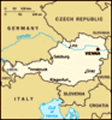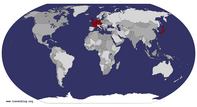Advertisement
Published: December 4th 2010
After having a rest at the hotel for a while, we started strolling through the town centre. It was rather warm in Graz in the afternoon on 25 September. We both went out without wearing jackets.
Mariahilf Hotel was standing along the Mur river, and close to local amenities and sightseeing places around the city centre. We walked around the city centre, i.e. Hauptplatz, popped in the tourist information centre, and stopped at Schlossbergplatz.
Mur Island
While crossing over the river, we noticed a peculiar looking object, which resembles a giant open mussel, floating in the middle of the river. We were certainly interested in the futuristic object, and decided to go through the walkway on the way to our hotel. We saw a stylish cafe and amphitheatre in the futuristic building.
Mariahilfkirche
There were several baroque buildings among red-tied roof houses in Graz. Mariahilfkirche is one of the typical baroque buildings. We visited there in the late afternoon on 25 September. As a typical Catholic church, there were a number of ornate mythological decorations on the altarpiece, ceiling and wall. The treasure included a beautiful portrait "Our Lady of Mercy" painted by Giovanni Pietro de Pormis.
We also looked round the museum adjacent to the church. The museum presented quite interesting items, e.g. waxworks of different types of saints, intricate carvings installed on the walls, paintings illustrating famous mythological scenes in the old and new testaments, which have been used for decorations in the Catholic churches. The art collections looked different from what we often see in English churches.
Schlossberg
After sorting out our travel itineraries, we walked to the Schlossberg. We climbed on the steps to Glockentum (Bell Tower). We learnt that German soldiers added some steps during the World War I. As well as being a symbol of Graz, the bell tower's clock is still in operation. It is tricky to find the time on the clock, as its hands were operating the other way round; the long one indicates the hour, and the short one shows the minutes.
Next, we walked through the garden near the bell clock. We overlooked the Old Town, consisting of red-tiled houses, green domes of baroque cathedrals and churches.
After taking photos of Graz's Old Town, we walked to the highest position of the site. It was rather cloudy day on 26 September, but we
could still see the surrounding countryside, in addition to the Old Town. There were several indicators on the top of Schlossberg. They told us the approximate miles to destinations, e.g. London, Moscow. The bell was ringing while we were standing in the viewpoint in the lunchtime. There was a beer garden restaurant on top of Schlossberg. People who were looking in the kitchen didn't seem to be able to speak English. I spoke to the cashier what we wanted. He seemed to have a little knowledge of English, and we managed to order sausage & roll, and drink at the beer garden.
State Park
After the lunch, we walked down to the old town, and headed for the State Park, lies in the east of Schlossberg. The autumn seemed to have arrived around Graz on 26 September. A lot of foliage had already turned gold and fallen on the ground. We saw a pheasant and red squirrels running across the field and trunks of the big trees. There were a number of fountains and sculptures in the State Park. At the heart of the park there was a splendid fountain with ornate carvings and statues. Beside the fountain, there
was a big mismatching object which is meant to be a rusty nail, and it made a humorous atmosphere in the peaceful park. We entered the Burggarten, and found it a very peaceful and tranquil space. Added to this, there was a trial garden with loads of colourful dahlias and a couple of greenhouses and orangey.
Glokenspielplatz
Afterwards, we walked through Hafgasse where a number of medieval buildings e.g. Cathedral were standing, and encountered the Glockenspiel. At 3pm two wooden figures in traditional costumes appeared from the upper floor window and danced with the folk music. The cobbled street led us to Sporgasse, shopping street near the central square. We did some shopping in the Austrian sweet shop. There were heaps of Mozart chocolates on the shelves and baskets at the sweet shops in Graz.
Natural History Museum, Graz
We arrived at the Natural History Museum at 4pm on 27 September, however, we managed to see most of the exhibition rooms. We looked at different types of fossils, rocks, and minerals with a wide variety of features, shapes, and colours kept in the glass cases, extinct ammonites fossilised giant trees, and animals seen in Austria. They all showed
us the story of 500 millions of Styrian geology, and habitats from high mountains to dense forest.
Styrian Restaurant, Graz
We went to the traditional Styrian Restaurant at 10 Sackstrasse for the final night of Graz. The restaurant seemed to be very popular. We were asked if we would be able to finish by 8:00. The decorations of the restaurant included dry plants of hay, poppies, some orange and yellow flowers, vases, ornaments of mythological figures, cushions, and lit candles. The staff played Austrian folk music.
Mark ordered "pork dumplings, and cabbage salad with bacon" and I had beef, pineapples, and palenta in Styrian sauce, and beer. It was wonderful to have wonderful dishes in the typical Styrian restaurant. We collected the leaflet containing English information so that we will remember to come back there again.
Visit to Schloss Eggenberg
I heard the noise of rain at dawn on 27 September. It was raining heavily in Graz in the morning. We put on our waterproof coats and carried umbrellas when we left the hotel. We had planned visiting Schloss Eggenberg, which is standing in west outskirts of Graz. Mark needed to exchange his traveller cheques into currency.
After he got money exchanged, we got on the tram No. 1 to Schloss Eggenberg.
There was no signpost for Schloss Eggenberg around the tram terminal. It took some time for us to find the destination, which was tucked away from the main street. After entering the parkland, we followed the path to the palace. We decided to buy combined tickets for us to look round the staterooms and galleries.
State Rooms
We were told that the guided tour was due to start at 11:00. Luckily, the staff arranged for an English-speaking guide who was able to explain the background of the house and treasure kept in the house. We were, first of all, invited to the reception room, which is the centre of grand palace with 365 windows. The lady explained to us that the house was built for Prince Johann Ulrich in 1623. She added that he was not from the aristocrat family, but became wealthy after he had been working for the Imperial family for a long time. She took us to the Drawing Rooms, Saloon, Dining room, bedroom, and India Room on the anticlockwise direction from the main reception room.
During the tour,
she showed us a number of art collections which Prince Johann Ulrich bought for the house. The art collections included astronomical, zodiac paintings, religious scenes, landscape and historical paintings, and portraits of Maria Theresa and her husband who stayed in Eggenberg twice or three times in their life. She pointed at paintings on the corners of one of the Drawing Rooms, which were meant to be the images of four Continents; Africa, Eurasia, America, and Asia. She explained to us that those paintings were completed 400 years ago, and so they may not be completely accurate to the images of the present day.
When we reached the room called "India Room", the guide told us that Austrians thought all products made of oriental countries e.g. China, Japan were originated from India, and the residents named "India Room, although much of the artefacts decorated in the room are made of China and Japan.
Like many of the properties in central Europe, much of the interior furnishings or treasure were sold or lost during the war and post war occupation period. The guide showed us some of the remaining treasures e.g. 17th century tapestries with Eggenberger coats of arms.
Finally,
she showed us the bed where Maria Theresa slept and told that she didn't feel comfortable to sleep on the bed laid with thin bed cover on the hard wood. It also took a long time to get the spacious room heated, so she didn't feel pleasant and warm to stay in Eggenberg as Shonnbrunn Palace.
We were very fortunate to have met a wonderful Austrian lady who showed us the staterooms with excellent speech.
Medieval Art Gallery on 1st floor
After leaving the tour, we started looking round the Medieval Art Gallery on the 1st floor. The art collections included altarpieces with mythological figures, troops, and worshippers, carvings of different types of saints, and religious paintings. Some medieval paintings presented very cruel scenes e.g. people being executed, tortured, and threatened, in line with the part of the mythological stories. As the majority of the nation follows the Catholics, I feel religious paintings and art works are highly respected, and very well preserved. They conveyed to us strong impact of the Catholic world.
Pavilion Cafe, Planet Garden
We decided to have lunch at the Pavilion Cafe in the Schloss Eggenberg. We both had apple strudel and hot drinks for lunch. The weather improved in the afternoon. We walked around the planet and formal garden around the palace. The planet garden consisted of several borders which were named after Planets which circle around the Sun. There were white flowers in the border of "Moon", sunflowers and orange flowers in the border named "Sun", shrubs with red berries planted on the border of "Mars".
Medieval Art Gallery on ground floor
After walking around the formal gardens, we began looking round the gallery on the ground floor. Many paintings illustrated ceremonial events with the presence of archbishops and their followers on the background of famous Catholic churches and cathedrals in Austria and Germany.
Parkland
The sunny weather in the afternoon encouraged us to walk in the romantic parkland. There were a number of peacocks and ducks in the peaceful park and pond. We took several pictures with autumn coloured leaves, Austrian mansion, and a couple of statues while ambling in the parkland.
Advertisement
Tot: 0.198s; Tpl: 0.012s; cc: 17; qc: 54; dbt: 0.1217s; 1; m:domysql w:travelblog (10.17.0.13); sld: 1;
; mem: 1.2mb










